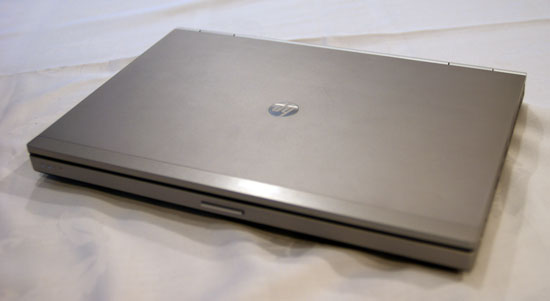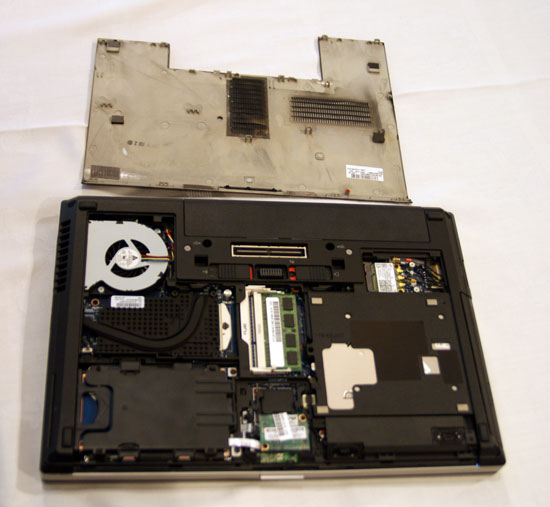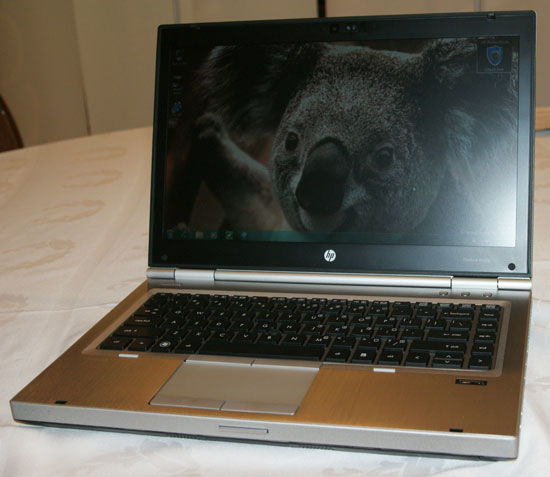Coming in March: HP Updates in a Big Way
It's fair to say the refreshes HP announced for their consumer computers earlier this month seemed fairly lackluster. While nobody can complain about improved notebook speakers and the triumphant return of dedicated mouse buttons, there wasn't anything else remarkably fresh or exciting about their spring line. When we got a chance to meet with HP representatives in San Francisco to see their new business lineup, however, we saw very nearly the complete opposite.

HP's EliteBook and ProBook lines have undergone a major overhaul since the last time we looked at them, whichwasn't very long ago. The last one we saw was fairly attractive but seemed somewhat schizophrenic in its aesthetics, like a hodgepodge of elements from enterprise and consumer lines that didn't blend together. It was the notebook equivalent of the American version of The Ring, appropriating scenes from its predecessor while gracelessly trying to integrate new material.
That's not the case with the new lineup. HP's designers have produced what have to be some of the most stylish notebooks we've seen, marrying some of the better trends in consumer notebooks to thoughtful, modern-looking engineering and design. You could argue they're cribbing from Apple a little bit, but that would do them a disservice.

HP is using aluminum on the lids of all of their new enterprise notebooks along with a single piece of machined aluminum for the interior panel with the ports cut into it. Internally they've employed a magnesium alloy chassis, and together with the aluminum shell these notebooks feel incredibly rigid and durable. In fact, in addition to having a mag-alloy backplane for the screen, HP also uses rubber padding between the bezel and screen to ensure it never compresses against the keyboard the way some cheaper notebooks can.
That keyboard is spill-resistant, with channels built into the frame beneath it, though depending on how you feel about the keyboards HP employs on their consumer line you may be pleased or disappointed to see the same chiclet-style keys on their enterprise-class kit. They've also gotten rid of touch-based buttons along with pretty much the entire control bar above the keyboard, instead replacing it with a couple of actual quick-access buttons. It's a decision that simplifies the look while improving usability.
What was probably my personal favorite feature had to be the bottom panel mechanism they're using on these new notebooks. Check this out:

The bottom panel of the notebook is a single large piece that can be removed by simply squeezing a latch and sliding it off, allowing for easy access to all of the internals. It's such a smart idea that one wonders why we don't see it more often—we'd love to get such a feature on more consumer laptops! And for the IT people that don't want to worry about employees popping it off and potentially damaging the components, the mechanism can be locked by installing a single screw. Most people probably won't get that much mileage out of something like this, but it does make the notebook easier to service, along with being easier for people like me (and at least a couple of you) to tinker with.
The EliteBook, ProBook b-series, and ProBook s-series
HP has divided their enterprise machines into three different lines. In descending order, they are the EliteBook p-series, the ProBook b-series, and the ProBook s-series. All of the features mentioned on the previous page are integrated into each of these lines, so it's largely a matter of market segmentation.
The EliteBook p-series
HP's big daddy line is the EliteBook p-series. These notebooks will be available in 14-inch and 15.6-inch models.

HP was quite proud to show these off and to be fair, they're mighty attractive. The major differentiators here are a silver outer shell with increased durability inside, designed to be as rugged and durable as possible. Perks include a chemically-strengthened glass touchpad designed to be simultaneously more comfortable and more wear-resistant along with support for HP's Ultra-Capacity notebook battery slate, which HP rates at offering the 14-inch model up to a staggering 32 hours of battery life.
The p-series will come equipped with the new Sandy Bridge processors, but graphics support is somewhat disappointing, topping out at just the AMD Radeon HD 6470M. The 6470M has just 160 stream processors and support for GDDR5, making it feel a bit anemic for such a premium line, but AMD has apparently introduced technology comparable to NVIDIA's Optimus that enables switching between the Sandy Bridge IGP and the dedicated AMD graphics. We hope to get a look at this in the near future.
The EliteBook notebooks start at $999.
The ProBook b-series
Stepping down to the ProBook b-series means moving to a slightly less rugged but still durable shell colored in a gunmetal shade of gray. You still get most of the perks, but HP hasn't announced availability of discrete graphics options for these notebooks. These can be ordered with processors ranging from the top-end Core i7 Sandy Bridge chips down to the lowly Celerons.
HP's ProBook b-series will start at $799 and will be available in 13.3-inch, 14-inch, and 15.6-inch form factors.
The ProBook s-series
One would be tempted to call the s-series the budget line of the bunch, but that's not entirely fair. These notebooks include many of the same design perks of the b-series and EliteBooks, with the primary differentiators seeming to be the latches on the lids and a slightly less generous port selection (upon inspection these looked to be missing FireWire and ExpressCard ports).
The flipside is that HP will be offering discrete graphics in these notebooks, though they haven't announced yet which models will be available except to say they'll be AMD Radeons. They'll also run a larger gamut of sizes, being available in 13.3-inch, 14-inch, 15.6-inch, and 17.3-inch models. Overseas there will be an additional 12.1-inch model, though unfortunately it doesn't look like we'll get to enjoy it in the states. Sales of ultraportables out here are fairly low while the Asian markets tend to eat them up and forego the larger desktop replacement models.
HP's ProBook s-series will start at $579.
Conclusion: Back, in Style
If this preview seems like a bit of a puff piece, I apologize. Having had the chance to sit down and actually see and play with these notebooks in person was a treat, if for no other reason than seeing what might hopefully become a minor sea change in enterprise hardware.
Simply put, HP's new EliteBook and ProBook machines are the kinds of smart, appealing designs that consumers even outside of the business world may want, and HP seems to have achieved to an extent the kind of crossover success in styling that Apple's MacBook Pro enjoys. They're so nice, in fact, that they make me wonder why anyone would bother with HP's warmed over consumer models—that is until I realize that for many users, the price tag is the bottom line. To each their own, but it looks like you'll get what you pay for if you spend up on one of these.
It would be remiss not to mention that all of these notebooks come equipped with USB 3.0 and Sandy Bridge processors, and the EliteBook and ProBook b-series also support integrated WAN. When HP first told me they had chosen to go with AMD Radeons for the line, I was confused: at this juncture, NVIDIA's 500M series with Optimus technology seemed like a clear win and a no-brainer. But AMD seems to have an ace up their sleeve with Power Express switchable graphics, a feature you can actually find on notebooks on retail shelves right now. It's perplexing as to why AMD isn't promoting this more since it puts them back on parity with NVIDIA in the mobile sector, but we'll have to get a Power Express-equipped notebook in house before we can say more.
HP is expecting to have their new lines available on March 15 and we've been told to expect to have review hardware in hand. Hopefully it won't be long until we can give one of these notebooks a more thorough investigation.

